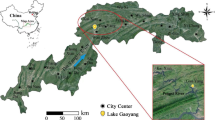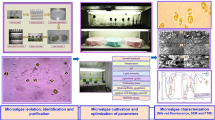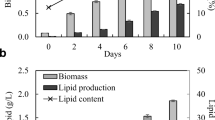Abstract
Biodiesel from microalgae seems to be the only renewable biofuel that has the potential to completely replace the petroleum-derived transport fuels. Therefore, improving lipid content of microalgal strains could be a cost-effective second generation feedstock for biodiesel production. Lipid accumulation in Scenedesmus obliquus was studied under various culture conditions. The most significant increase in lipid reached 43% of dry cell weight (dcw), which was recorded under N-deficiency (against 12.7% under control condition). Under P-deficiency and thiosulphate supplementation the lipid content also increased up to 30% (dcw). Application of response surface methodology in combination with central composite rotary design (CCRD) resulted in a lipid yield of 61.3% (against 58.3% obtained experimentally) at 0.04, 0.03, and 1.0 g l−1 of nitrate, phosphate, and sodium thiosulphate, respectively for time culture of 8 days. Scenedesmus cells pre-grown in glucose (1.5%)-supplemented N 11 medium when subjected to the above optimized condition, the lipid accumulation was boosted up to 2.16 g l−1, the value ~40-fold higher with respect to the control condition. The presence of palmitate and oleate as the major constituents makes S. obliquus biomass a suitable feedstock for biodiesel production.






Similar content being viewed by others
References
Alcantara R, Amores J, Canoira L, Fidalgo E, Franco MJ, Navarro A (2000) Catalytic production of biodiesel from soybean oil, used frying oil and tallow. Biomass Bioenergy 18:515–527
Becker K, Francis G (2002) Biodiesel from Jatropha plantations on degraded land. A brief technical report. University of Hohenheim, Stuttgrart
Behrens PW, Kyle DJ (1996) Microalgae as a source of fatty acids. J Food Lipids 3:259–272
Bligh EG, Dyer WJ (1959) A rapid method of total lipid extraction and purification. Can J Biochem Physiol 37:911–917
Brown AC, Knights BA, Conway E (1969) Hydrocarbon content and its relationship to physiological state in the green alga Botryococcus braunii. Phytochemistry 8:543–547
Canakci M, Gerpen JV (2001) Biodiesel production from oil and fats with high free fatty acids. Trans ASAE 44:1429–1436
Chisti Y (2007) Biodiesel from microalgae. Biotechnol Adv 25:294–306
Dayananda C, Sarada R, Usha Rani M, Shamala TR, Ravishankar GA (2007) Autotrophic cultivation of Botryococcus braunii for the production of hydrocarbons and exopolysaccharides in various media. Biomass Bioenergy 31:87–93
Doi Y (1990) Microbial Polyesters. VCH, New York
Dorado MP, Ballesteros E, Almeida JA, Schellert C, Lohrlein HP, Krause R (2002) An alkali-catalyzed transesterification process for high free fatty acid waste oils. Trans ASAE 45:525–529
Feng F-Y, Yang W, Jiang G-Z, Xu Y-N, Kuang T-Y (2005) Enhancement of fatty acid production of Chlorella sp. (Chlorophyceae) by addition of glucose and sodium thiosulphate to culture medium. Process Biochem 40:1315–1318
Ghadge SV, Raheman H (2005) Process optimization for biodiesel production from mahua (Madhuca indica) oil using response surface methodology. Bioresour Technol 97:379–384
Haag AL (2007) Algae bloom again. Nature 447:520–521
Illman AM, Scragg AH, Shales SW (2000) Increase in Chlorella strains calorific values when grown in low nitrogen medium. Enzyme Microb Technol 27:631–635
Lang X, Dalai AK, Bakhshi NN, Reany MJ, Hertz PB (2001) Preparation and characterization of biodiesel from various bio-oils. Bioresour Technol 80:53–62
Liu Z-Y, Wang G-C, Zhou B-C (2008) Effect of iron on growth and lipid accumulation in Chlorella vulgaris. Bioresour Technol 99:4717–4722
Miao X, Wu Q (2004) High yield bio-oil production from fast pyrolysis by metabolic controlling of Chlorella protothecoides. J Biotechnol 110:85–93
Minowa T, Yokoyama S-Y, Kishimoto M, Okakurat T (1995) Oil production from algal cells of Dunaliella tertiolecta by direct thermochemical liquefaction. Fuel 74:1735–1738
Mittelbach M, Pokits B, Silberholz A (1992) Production and fuel properties of fatty acid methyl esters from used frying oil. In: Liquid Fuels from Renewable Resources: Proceedings of an Alternative Energy Conference, St. Joseph, Mich, ASAE, pp. 74–78
Montgomery DC (2001) Design and analysis of experiments, 5th edn. Wiley, New York
Myers RH, Montgomery DC (2002) Response surface methodology: process and product optimization using designed experiments, 2nd edn. Wiley, New York
Ohlrogge J, Browse J (1995) Lipid biosynthesis. Plant Cell 7:957–970
Rai LC, Mallick N, Singh JB, Kumar HD (1991) Physiological and biochemical characteristics of a copper tolerant and a wild type strain of Anabaena doliolum under copper stress. J Plant Physiol 138:68–74
Rao G, Mutharasan R (1988) Altered electron flow in a reducing environment in Clostridium acetobutilicum. Biotech Lett 10:129–132
Rhee GY (1978) Effect of N:P atomic ratio and nitrate limitation on algal growth, cell composition and nitrate uptake. Limnol Oceanogr 23:10–25
Richardson B, Orcutt DM, Schwertner HA, Martinez Cara L, Wickline Hazel E (1969) Effects of nitrogen limitation on the growth and composition of unicellular algae in continuous culture. Appl Micobiol 18:245–250
Shiflin NS, Chisholm SW (1981) Phytoplankton lipids: interspecific differences and effects of nitrate, silicate and light dark cycles. J Phycol 17:374–384
Soeder CJ, Bolze A (1981) Sulphate deficiency stimulates the release of dissolved organic matter in synchronus culture of Scenedesmus obliquus. Physiol Pl 52:233–238
Vicente G, Martınez M, Aracil J (2004) Integrated biodiesel production: a comparison of different homogeneous catalysts systems. Bioresour Technol 92:297–305
Xu H, Miao X, Wu Q (2006) High quality biodiesel production from a microalga Chlorella protothecoides by heterotrophic growth in fermenters. J Biotechnol 126:499–507
Acknowledgements
The authors would like to thank Mr. Subhash Chand for his assistance and Mr. Shovon Mandal is thankful to the Indian Institute of Technology Kharagpur, India, for providing fellowship.
Author information
Authors and Affiliations
Corresponding author
Rights and permissions
About this article
Cite this article
Mandal, S., Mallick, N. Microalga Scenedesmus obliquus as a potential source for biodiesel production. Appl Microbiol Biotechnol 84, 281–291 (2009). https://doi.org/10.1007/s00253-009-1935-6
Received:
Revised:
Accepted:
Published:
Issue Date:
DOI: https://doi.org/10.1007/s00253-009-1935-6




